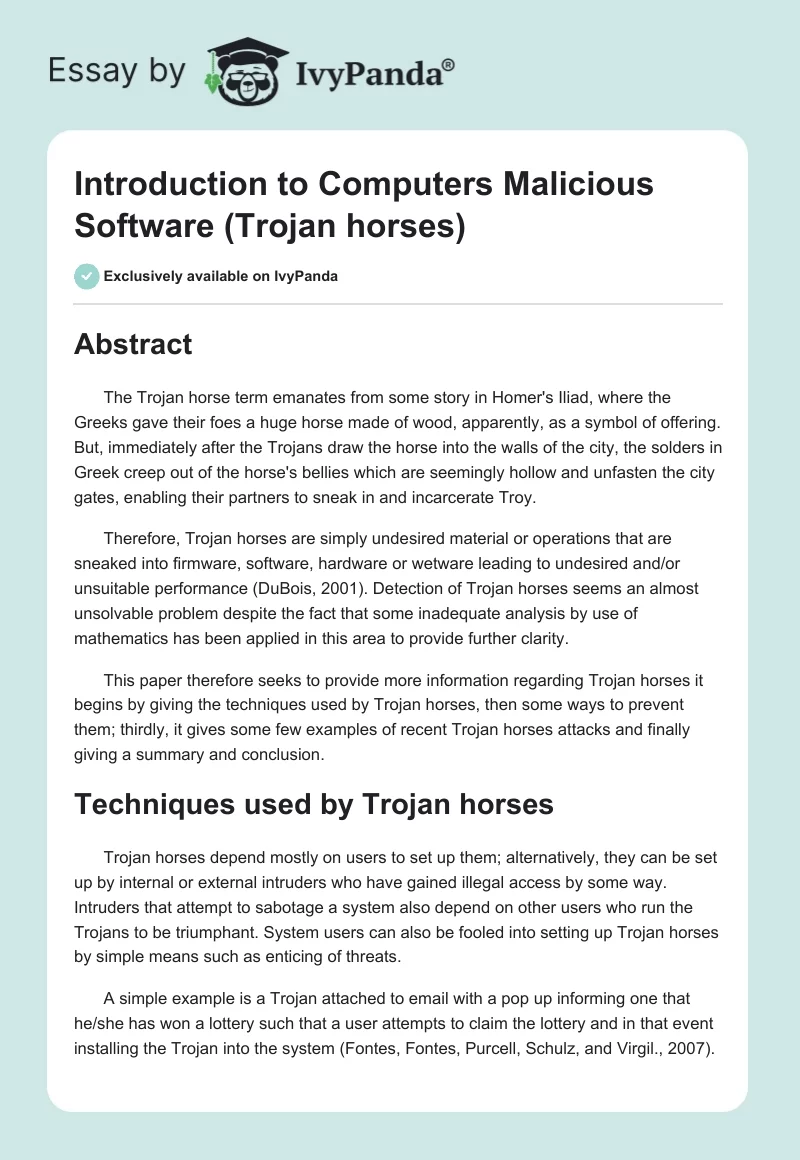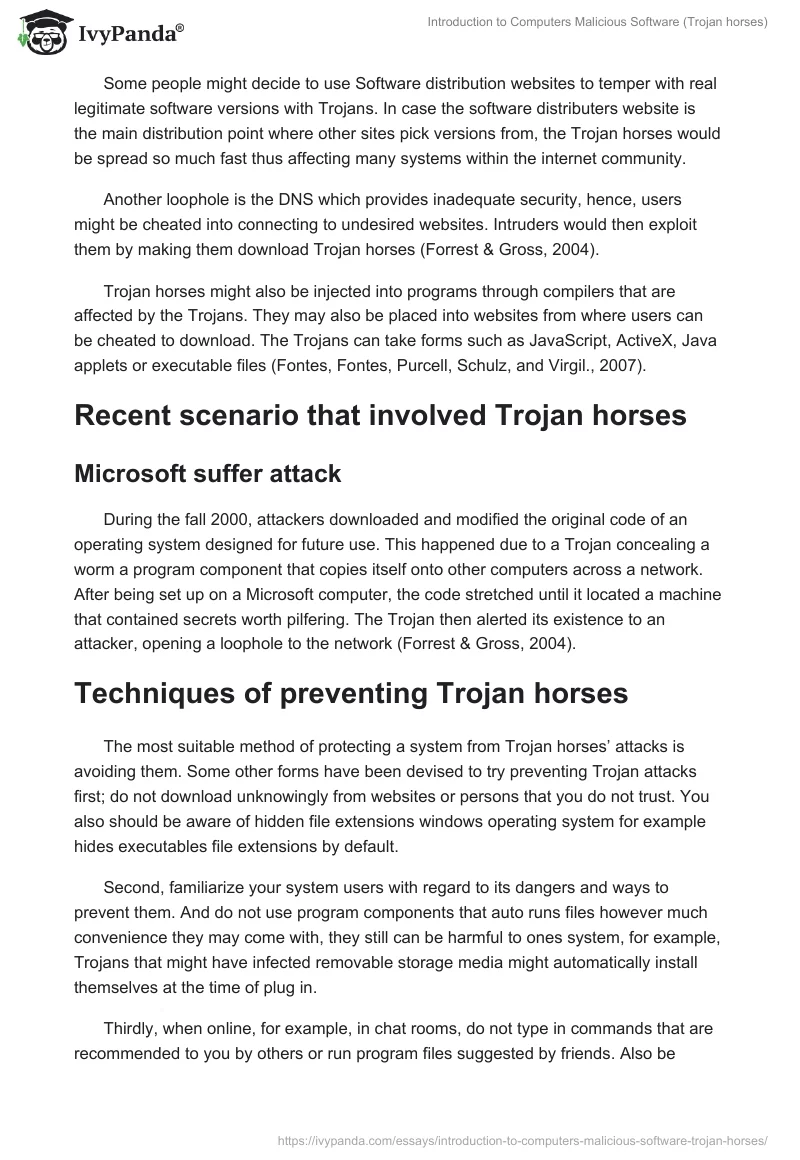Abstract
The Trojan horse term emanates from some story in Homer’s Iliad, where the Greeks gave their foes a huge horse made of wood, apparently, as a symbol of offering. But, immediately after the Trojans draw the horse into the walls of the city, the solders in Greek creep out of the horse’s bellies which are seemingly hollow and unfasten the city gates, enabling their partners to sneak in and incarcerate Troy.
Therefore, Trojan horses are simply undesired material or operations that are sneaked into firmware, software, hardware or wetware leading to undesired and/or unsuitable performance (DuBois, 2001). Detection of Trojan horses seems an almost unsolvable problem despite the fact that some inadequate analysis by use of mathematics has been applied in this area to provide further clarity.
This paper therefore seeks to provide more information regarding Trojan horses it begins by giving the techniques used by Trojan horses, then some ways to prevent them; thirdly, it gives some few examples of recent Trojan horses attacks and finally giving a summary and conclusion.
Techniques used by Trojan horses
Trojan horses depend mostly on users to set up them; alternatively, they can be set up by internal or external intruders who have gained illegal access by some way. Intruders that attempt to sabotage a system also depend on other users who run the Trojans to be triumphant. System users can also be fooled into setting up Trojan horses by simple means such as enticing of threats.
A simple example is a Trojan attached to email with a pop up informing one that he/she has won a lottery such that a user attempts to claim the lottery and in that event installing the Trojan into the system (Fontes, Fontes, Purcell, Schulz, and Virgil., 2007).
Some people might decide to use Software distribution websites to temper with real legitimate software versions with Trojans. In case the software distributers website is the main distribution point where other sites pick versions from, the Trojan horses would be spread so much fast thus affecting many systems within the internet community.
Another loophole is the DNS which provides inadequate security, hence, users might be cheated into connecting to undesired websites. Intruders would then exploit them by making them download Trojan horses (Forrest & Gross, 2004).
Trojan horses might also be injected into programs through compilers that are affected by the Trojans. They may also be placed into websites from where users can be cheated to download. The Trojans can take forms such as JavaScript, ActiveX, Java applets or executable files (Fontes, Fontes, Purcell, Schulz, and Virgil., 2007).
Recent scenario that involved Trojan horses
Microsoft suffer attack
During the fall 2000, attackers downloaded and modified the original code of an operating system designed for future use. This happened due to a Trojan concealing a worm a program component that copies itself onto other computers across a network. After being set up on a Microsoft computer, the code stretched until it located a machine that contained secrets worth pilfering. The Trojan then alerted its existence to an attacker, opening a loophole to the network (Forrest & Gross, 2004).
Techniques of preventing Trojan horses
The most suitable method of protecting a system from Trojan horses’ attacks is avoiding them. Some other forms have been devised to try preventing Trojan attacks first; do not download unknowingly from websites or persons that you do not trust. You also should be aware of hidden file extensions windows operating system for example hides executables file extensions by default.
Second, familiarize your system users with regard to its dangers and ways to prevent them. And do not use program components that auto runs files however much convenience they may come with, they still can be harmful to ones system, for example, Trojans that might have infected removable storage media might automatically install themselves at the time of plug in.
Thirdly, when online, for example, in chat rooms, do not type in commands that are recommended to you by others or run program files suggested by friends. Also be cautionary when dealing with ActiveX, JavaScript or Java applets controls from pages of websites. It is advisable to configure one browser to disable execution of files automatically.
Fourthly, apply firewalls and virus protection software’s that adequately combat Trojan horses. Despite the fact that it might be difficult to detect all Trojan horses, the software’s will aid along way in combating them (DuBois, 2001).
Conclusion
Trojans reflect a great internal threat to the integrity of an institutions entire network. They seem pretty tough to detect as opposed to viruses and other malicious software since they are distributed alongside recompiled file name attributes. They may also vary from simple keystrokes log made on personal computers to fully developed remote control Trojans that affect commercial systems to look vague by giving some authority to compromised users who can temper with the entire network.
Despite the security, mechanisms put in place close to all networks are exposed to weaknesses of human gullibility (Forrest & Gross, 2004). Hence, all system users must consider the small mistakes we neglect since those are the loopholes that Trojans exploit.
References
DuBois, P. (2001). Trojan horses : saving the classics from conservatives. New York : New York Univ. Press.
Fontes, J., Fontes, R., Purcell, G., Schulz, B. J., & Virgil. (2007). The Trojan horse : the fall of Troy : a Greek legend. Minneapolis: Graphic Universe.
Forrest, B., & Gross, P. R. (2004). Creationism’s Trojan horse : the wedge of intelligent design. New York: Oxford University Press.


